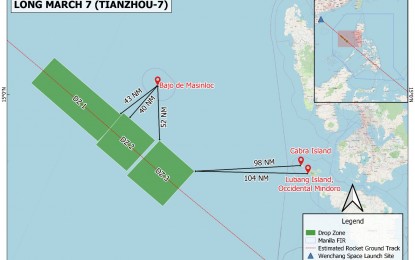
(Map courtesy of Philippine Space Agency)
MANILA – The Philippine Space Agency (PhilSA) announced on Thursday three possible drop zones of debris from the Long March 7 rocket that was launched in Hainan, China on Wednesday night.
In an advisory, the PhilSA said the debris could have fallen within these drop zones (DZ): approximately 43 nautical miles (DZ 1), 40 nautical miles (DZ 2) way from Bajo de Masinloc, and DZ 3 was identified 52 nautical miles away from Bajo de Masinloc and 98 nautical miles away from Cabra Island.
Earlier, PhilSA's Space Technology Missions & Systems Bureau director Marc Talampas said every time a rocket is launched from Wenchang Space Launch Center, they expect the debris to fall on Philippine coastal waters.
The debris could float around the area and wash toward nearby coasts. As such, the public was warned against retrieving or coming in close contact with these materials that may contain remnants of toxic substances such as rocket fuel.
Those who might accidentally touch the debris should immediately wash their hands, the PhilSA said.
"Unburned debris from rockets, such as the booster and faring, are designed to be discarded as the rocket enters outer space," PhilSA's advisory read.
Though not projected to fall on land features or inhabited areas, falling debris poses danger and potential risk to ships, aircraft, fishing boats, and other vessels that will pass through the drop zone, it added.
The PhilSA said details of drop zones were disclosed through a Notice to Airmen warning of an aerospace flight activity.
The public is enjoined to report to local authorities if they see suspected debris.
Finding the location of debris is essential for scientists to determine the accuracy of the estimated debris drop zones, the PhilSA said. (PNA)
